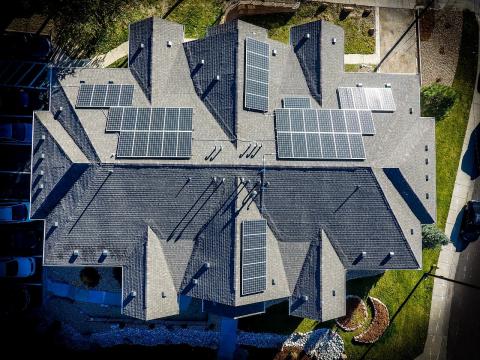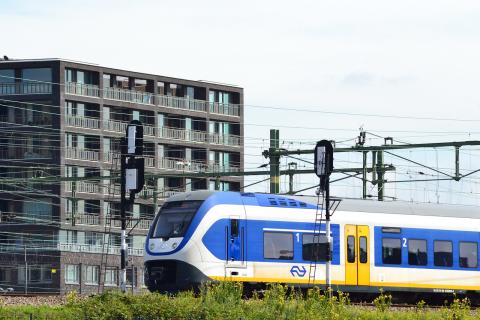
A sustainable office: what are the advantages and how do you achieve it?

Sustainable offices are a hot topic. Sustainability means that they want to maintain a clean, green and pleasant living environment, also for future generations, in order to provide for the necessities of life. Every environmentally conscious contribution counts and that is why in this blog the benefits of sustainability in the office will be explained and tips on how to achieve a sustainable office building will be provided.
Why choose sustainability?
The main reason for opting for sustainability is, of course, to have as little impact on the environment as possible. Sustainable solutions are important both for your business and for the planet. Without a healthy planet, your company will not be able to function. In addition, making the office more sustainable also has more plus points than is initially thought.
A more sustainable office can yield financial benefits when energy and materials are used more intelligently. What is often underestimated is the positive influence on the company's image. A sustainable vision shows that your company cares about the future and the world around us. This can have a stimulating effect on sales and gives the brand a better image.
The benefits of sustainability in the office
In the following sections we briefly explain the main benefits of a sustainable office.
1. Competitive advantage
Firstly, companies mainly would like to reduce their energy bills. This can be achieved, for example, by using green electricity in the form of solar panels or wind energy. Eventually, this provides benefits for the energy bill, it ensures differentiation and green electricity does not burden the environment or at least to a smaller extent.
Unfortunately, on the short term, green electricity does not yet offer much in the way of cost savings. Grey electricity is still cheaper to use but it does not have unlimited use. Grey electricity is produced from fossil fuels, which releases CO2. This has a negative impact on the earth and fossil fuels may become scarce in the long run, causing prices to rise significantly. Therefore, green electricity can actually provide a competitive advantage in terms of costs and company image.
2. Higher profits in the long run
Despite the fact that the use of green electricity does not directly result in a cost advantage, you are investing in higher profits in the long term. There is in fact a correlation between environmental performance and financial economic performance. Sustainability can increase sales, reduce energy, waste, material, water and labour costs, and also reduce strategic and operational risks.
A sustainable vision makes for an innovative policy plan. A new green approach can help with advertising and marketing functions, spreading a positive image among the target group, which also helps to increase market share.
3. Possible subsidies
When a company demonstrably invests in sustainability, it contributes to a healthy and sustainable world. In some countries, the government therefore provides a subsidy to reward the investment. In the Netherlands, this is measured by the CO2 Performance Ladder. When a company certifies for the ladder, and thus demonstrably commits to CO2 reduction (in the office), a company can receive compensation in terms of lower energy costs, material savings and innovation gains.
4. Reputation and image boost
Opting for a sustainable office requires some form of research into your company's footprint. To form a long-term vision about the footprint, the company's policy will have to be adjusted accordingly. It requires inspiring leadership and employee engagement to develop a long-term sustainable policy to which a sustainable office fits.
A sustainable and meaningful office, in line with the policy, makes your company future-proof and progressive. This inspiring vision attracts employees and makes them feel useful. Combining this with allowances for train travel and encouraging home working, for example, shows that the company wants to contribute to an environmentally friendly world. There is no better advertisement for a company than an image based on reality and transparency.
Tips for a sustainable office
Improve the world and start with your office! Sustainability within the company and in the office has several advantages, as discussed in the previous sections. With the following tips you can actually put this into practice and achieve a more sustainable office.
Saving on energy
Saving on energy is popular in households, but office buildings can also make significant savings on energy consumption. To do so, you will have to do research, actively reduce energy consumption and, if necessary, switch to lower energy costs. Moreover, as of 1 January 2023, all offices in the Netherlands are expected to have energy label C. Otherwise these offices will be closed. The following savings can help you on your way to a more sustainable office:
- Use low-energy light bulbs, which provide an 80% advantage over "normal" light bulbs
- Use LED motion sensors for areas, such as meeting rooms or toilets, that are used less
- Pay attention to the use of heating and air conditioning. Check regularly that they are at the right temperature and use a clock thermostat.
- Also organise a warm jumper day and leave the heating off for a day.
- Make sure computers and laptops go to sleep modus after a few minutes and that they are turned off after work. Also switch off the printer when no one uses it.
- Make use of subsidies for green energy, such as solar panels. If necessary, do this in cooperation with several property owners.
- Make sure the radiators stand apart and the heat is not blocked by desks or cupboards.
- Evaluate the insulation in the office. For example, place radiator foil behind the radiators, apply draught strips to the windows and insulate the central heating pipes.
- When new appliances have to be bought, choose one with the most energy-efficient label (A+++).

Environmentally conscious office supplies
Green' alternatives can be found for almost all office supplies. Some examples of environmentally conscious office supplies are: recycled adhesive tape with water-based glue, refillable pens made of PET bottles, an erasable notebook or a laptop stand made of bamboo or cardboard.
In addition to office supplies, also think about climate-neutral printing. Approximately one fifth of the world's forest is felled to produce paper, which promotes CO2 reduction and makes biodiversity disappear. Therefore, try to print as little as possible and otherwise make sure that the paper has the TFC (Totally Chlorine Free) quality mark. The ink or toner in the printer also contributes to pollution and contamination by chemicals and metals. Make sure you use them sparingly and recycle the empty ink cartridges or choose an inkjet printer with bio-ink, eco-ink or vegetable ink. Finally, make sure the printer has the energy star label, which means that it saves 10 to 50 percent more energy compared to a non-energy efficient printer.
Sustainable office design
Do you need new office furniture or are you redecorating your office? Consider recycled furniture, cradle to cradle furniture or give your furniture a new life! Cradle to cradle (C2C) products can be 100% reused at the end of their lifespan and can be returned to the technical or biological cycle. This way, the furniture does not end up on the rubbish dump at the end of its life. If you are looking for a temporary office, you can also consider renting furniture.
Fair trade products and sustainable company canteen
An effortless way to become more sustainable in the office is to evaluate the food and drink supply. The following tips can help you set up a sustainable canteen and coffee corner in your office.
- Many cups of coffee and tea are consumed at the office. Make the switch to sustainable, organic or fair-trade brands.
- Avoid the use of disposable plastic and provide reusable tableware. Nowadays there are also sustainable coffee cups made of bamboo or FSC paper that are completely biodegradable.
- The meat, fish and dairy industries have a negative impact on the environment, for example through water consumption and CO2 emissions. Therefore, try to reduce the use of meat, fish and dairy products and serve for example vegetable alternatives.
- Prevent food waste. Pay attention to the expiry date of products and try to reuse leftovers for example in soups where possible.
- Encourage your employees to bring their own food instead of ordering it. This prevents packaging materials and CO2 emissions for the delivery of the order.

Ecological cleaning
Good hygiene in the office is of significant importance, especially since the pandemic. However, regular cleaning products contain many harmful substances such as chemicals. Therefore, choose ecological cleaning products based on biodegradable ingredients. Moreover, the packaging of sustainable cleaning products is made of recycled material. Also use sustainable sponges and cloths, such as a sponge from the Loofah plant, for cleaning. The standard green and yellow sponges leave microplastics behind in the water, which can eventually pollute the environment.
If you use an external company to clean your office premises, do your research on an environmentally friendly cleaning company.
Climate-friendly travel to work
Encourage employees to be conscious about the means of transport they use to get to work. When you travel by car, bus or plane, you put a burden on the environment because of the fuel that these transport burn. The most sustainable alternative is to travel by public transport such as train or bicycle. Try to stimulate this by introducing a business card for public transport, for example.
Also give your employees the opportunity to work from home. Less commuting (by car) reduces CO2 emissions, fine dust particles and traffic on the road and in the train. Moreover, working from home contributes to the well-being of your employees and you could eventually consider a hybrid office, which also saves on costs.

Find your sustainable office on flexas.com


